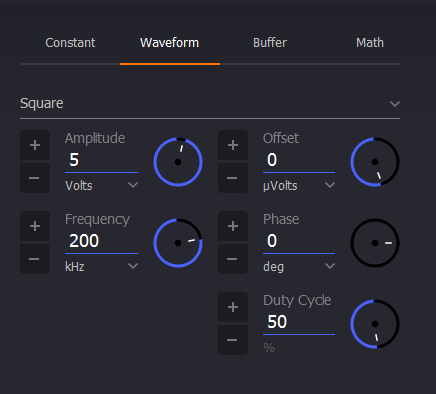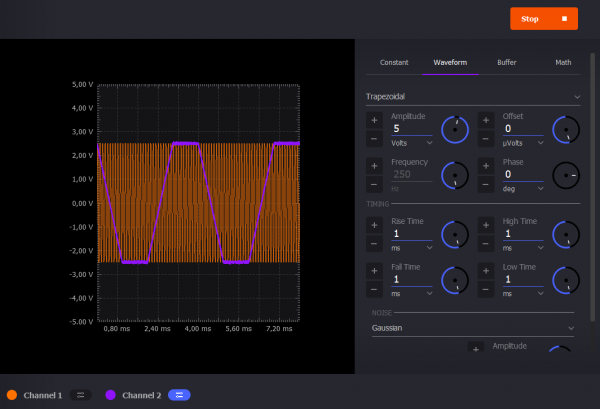Scopy Signal Generator
Video
General Description

The signal generator instrument can be used to generate analog output from the M2K with user configurable parameters. It consists of 3 parts:
Channel selector - enable/disable channels as well as each channel's control panel.
Signal Plot - visual representation of the signals
Control Panel - change signal paramteres

Four types of signals can be generated.
Constant - DC signal at a user selectable amplitude
Waveform - AC signal with various customizable parameters
Buffer - signal is imported from a file
Math - signal is defined by a mathematical equation
Constant signal only has one parameter which inputs the amplitude of the signal
Waveform signal type can be one of the following
Sine
Square
Triangle
Trapezoidal
Rising sawtooth
Falling sawtooth
All signals have amplitude, offset, phase and frequency parameters. Selecting Square wave will also unlock the duty cycle parameter. Selecting trapezoidal waveform will disable the frequency, as this parameter will be computed from the other 4 values in the Timing category (Rise time, High time, Fall time, Low Time)

Buffer signal type takes a file as an input.
The supported file types for buffered signals are:
.bin - 32 bit binary float format
.wav - Waveform Audio File Format (16 bit integers)
.csv - Comma separated values
.mat - MATLAB Mat format
CSV file format supports raw CSVs such as https://gist.github.com/adisuciu/7aa30bc9e545db23a17e86d23ae4f53c, as well as Scopy formatted CSVs such as https://gist.github.com/adisuciu/5abffa8233707c7b95585e80fbb1dde9. This means it is possible to acquire a signal in the oscilloscope and play it back in the signal generator.
This in not entirely true. The scope sample rate is 100 MSPS (or factors of ten less) and the signal generator sample rate is 75MSPS (or factors of 10 less) so scope samples do not inherently match up with generator samples. Scope samples would need to be re-sampled by a factor of 3 to 4 to have the signal frequency played back properly.
MAT file format only supports arrays of type real (no complex waveforms)

Math signal type allows generation of a signal that is defined as a math equation. .

On top of all the signals noise can be added. By selecting None, no noise is added to the signal. The rest of the noise types are:
Uniform
Gaussian
Laplacian
Impulse
The noise is only calculated once on the host, and simply added to the waveform buffer. This means that for cyclic waveforms the noise will be the same on each period.
Use cases
Create loopback between CH1 and CH2 of the oscilloscope and the signal generator
Run a single channel

Disable channel 2
Select sine wave with 5V amplitude and 10kHz
Run the signal generator
Monitor oscilloscope
Run both channels

Continue from previous testcase
Enable channel 2 and select triangle wave with 5V amplitude and 20kHz
Add gaussian noise with 1V amplitude
Monitor oscilloscope

Select square wave with 25% dutycycle
Decrease noise amplitude to 200mV
Monitor oscilloscope

Select trapezoidal waveform with 1ms rise/up/fall/low times
Monitor oscilloscope

Select buffer mode and select a wavefile. One can usually find a suitable wavefile in C:\Windows\Media
Signal generator automatically selects appropriate sample rate
Monitor oscilloscope (if possible connect a speaker to the channel that is outputted)

-
Remove noise, disable CH1 and increase amplitude to 5V
Monitor oscilloscope

Select Math mode and input a function such as 2*(cos(6000*pi*t)*sin(2000*pi*t))
Set sample rate to 75MSPS (this is the sample rate of the generated signal)
Set record run length to 1ms.
Run the signal
Monitor oscilloscope
Sample rate & record length parameters: Since t goes from 0 to infinity, we need to specify how long will t be generated for the specified function - in this case it will go from 0 to 1ms with 75
MSPS granularity(13.3333
ns). These settings will generate (1 * 10^-3) * (75 * 10 ^9) points = 75000 points.
Return to Scopy Main Page
